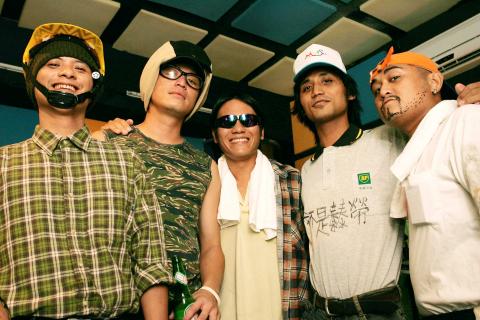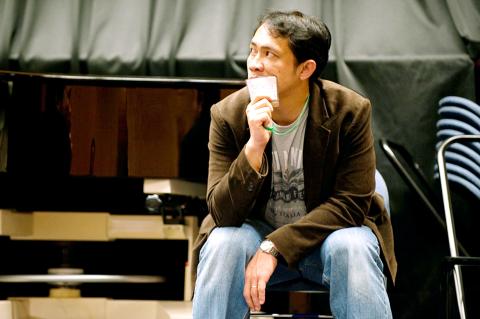“You’re just selfish. Get out!” the drummer of Aboriginal indie-rock band Totem (圖騰) screams at one of the group’s singers. The guitarist steps in to prevent the two from fighting. Audiences could be forgiven for thinking the band was going the way of the Sex Pistols, but Amis director Lungnan Isak Fangas (龍男‧以撒克‧凡亞思) staged the quarrel to “tease out the real emotions” in his latest “documentary,” which follows the group as it tries to make it big.
Fangas started the project after meeting Totem while filming 2004’s Ocean Fever (海洋熱), a documentary about Ho-Hai-Yan Rock Festival’s (國際海洋音樂祭) battle of the bands competition.
“Over the years I have seen Totem growing apart and its members complaining about each other, so I thought it was better to touch on a universal theme rather than just about the band,” the director said. “In talking-head documentaries, people exert constraints and exercise caution in front of the lens, whereas I want to reveal truth through drama ... I exaggerate those conflicting emotions and ask the documentary’s subjects to internalize them through each gesture they make and each word they say in what is mostly improvised performance.”

Photo: Courtesy of Good Day Films
The film interweaves scenes of the staged conflict, which is set in 2009, and the footage Fangas shot between Totem’s inception in 2003 and 2005, when the band won the contest at Ho-Hai-Yan.
As the off-screen narrator, lead singer Suming’s (舒米恩) viewpoint shapes the rock outfit’s past and present, gradually pulling audiences into the struggles of the aspiring musicians who quit their jobs to prepare for the contest.
Tension mounts among the band members and explosive confrontations follow, with drummer A-sheng (阿勝) accusing Suming of “double-crossing” the band because of his participation in Echo GS (艾可菊斯), a side project the Amis singer and songwriter formed with Rukai musician Gelresai (陳世川).

Photo: Courtesy of Good Day Films
Director Fangas’ effort to blur the line between documentary and fiction leaves room for narrative development, as the two segments appear tacked together, rather than forming an integral whole.
Lacking funding, the film was a labor of love for Fangas, who formed close bonds with the musicians.
The result is a strong sense of intimacy and trust, even during the film’s tenser moments, one of which involves a very natural “performance” by A-sheng, who tells Suming he has to quit the band to support his family, despite the fact that audience members know he plays drums with the band Matzka (瑪斯卡樂團), which is recently enjoying growing popularity.

Photo: Courtesy of Good Day Films
Fangas said he has been working on a feature-film project that will morph into an Amis musical, though Aboriginal culture is not his only area of interest.
“I keep my Han Chinese name Lungnan because that is how I am: a mix of Han Chinese culture and Amis inheritances,” the director says.
Fangas has also found inspiration in his position as presidential hopeful Su Tseng-chang’s (蘇貞昌) son-in-law. Still in production, this documentary follows the life of Fangas’ wife, a woman torn between her family and helping her father attain political office.
“It is a universal theme that all women can relate to,” the director says. “But, of course, it is also an elaborate piece of propaganda to make Su look good.”
Who is Singing There is currently on a free screening tour across the country. Its next stop is Kafka on the Shore Cafe (海邊的卡夫卡) tomorrow at 7pm in Taipei. Totem members Zamake (胡祝凱) and A-shin (阿新) will perform after the screening and along with the director will hold a question-and-answer session. For more information about the film, visit singingthere.pixnet.net/blog.

The Taipei Times last week reported that the rising share of seniors in the population is reshaping the nation’s housing markets. According to data from the Ministry of the Interior, about 850,000 residences were occupied by elderly people in the first quarter, including 655,000 that housed only one resident. H&B Realty chief researcher Jessica Hsu (徐佳馨), quoted in the article, said that there is rising demand for elderly-friendly housing, including units with elevators, barrier-free layouts and proximity to healthcare services. Hsu and others cited in the article highlighted the changing family residential dynamics, as children no longer live with parents,

It is jarring how differently Taiwan’s politics is portrayed in the international press compared to the local Chinese-language press. Viewed from abroad, Taiwan is seen as a geopolitical hotspot, or “The Most Dangerous Place on Earth,” as the Economist once blazoned across their cover. Meanwhile, tasked with facing down those existential threats, Taiwan’s leaders are dying their hair pink. These include former president Tsai Ing-wen (蔡英文), Vice President Hsiao Bi-khim (蕭美琴) and Kaohsiung Mayor Chen Chi-mai (陳其邁), among others. They are demonstrating what big fans they are of South Korean K-pop sensations Blackpink ahead of their concerts this weekend in Kaohsiung.

Oct 20 to Oct 26 After a day of fighting, the Japanese Army’s Second Division was resting when a curious delegation of two Scotsmen and 19 Taiwanese approached their camp. It was Oct. 20, 1895, and the troops had reached Taiye Village (太爺庄) in today’s Hunei District (湖內), Kaohsiung, just 10km away from their final target of Tainan. Led by Presbyterian missionaries Thomas Barclay and Duncan Ferguson, the group informed the Japanese that resistance leader Liu Yung-fu (劉永福) had fled to China the previous night, leaving his Black Flag Army fighters behind and the city in chaos. On behalf of the

I was 10 when I read an article in the local paper about the Air Guitar World Championships, which take place every year in my home town of Oulu, Finland. My parents had helped out at the very first contest back in 1996 — my mum gave out fliers, my dad sorted the music. Since then, national championships have been held all across the world, with the winners assembling in Oulu every summer. At the time, I asked my parents if I could compete. At first they were hesitant; the event was in a bar, and there would be a lot